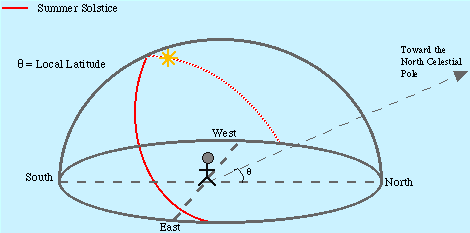

After the summer solstice the Sun follows a lower and lower path through the sky each day until it reaches the point where it is in the sky for exactly 12 hours again. This is the Fall Equinox. Just like the Spring Equinox, the Sun will rise exactly east and set exactly west on this day and everyone in the world will experience a 12 hour day.
After the Fall Equinox the Sun will continue to follow a lower and lower path through the sky and the days will grow shorter and shorter until it reaches its lowest path and then we are back at the Winter Solstice where we started.
In each of the diagrams displaying the path of the Sun for different
times of the year you might have noticed an arrow pointing towards the
North Celestial Pole. We need to understand why the location of the North
Celestial Pole
is important in building our sundials. Let's find
out!
![]()
![]()

![]()